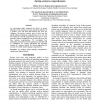Free Online Productivity Tools
i2Speak
i2Symbol
i2OCR
iTex2Img
iWeb2Print
iWeb2Shot
i2Type
iPdf2Split
iPdf2Merge
i2Bopomofo
i2Arabic
i2Style
i2Image
i2PDF
iLatex2Rtf
Sci2ools
162
click to vote
LLC
2016
2016
Visually Situated Language Comprehension
An eye-tracking study compared the effects of actions (depicted as tools between on-screen characters) with those of a speaker’s gaze and head shift between the same two characters. In previous research, each of these cues has rapidly influenced language comprehension on its own, but few studies have directly compared these two cues or, more generally, distinct non-linguistic cues in their effects on realtime sentence comprehension. We investigated how participants used action tools and speaker gaze separately and in combination for visually anticipating the upcoming mention of a sentence referent. We discuss implications for accounts of visually situated language comprehension.
Related Content
| Added | 07 Apr 2016 |
| Updated | 07 Apr 2016 |
| Type | Journal |
| Year | 2016 |
| Where | LLC |
| Authors | Pia Knoeferle, Ernesto Guerra |
Comments (0)

